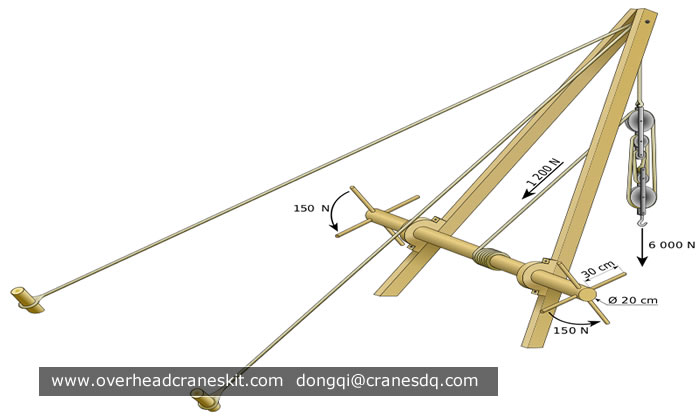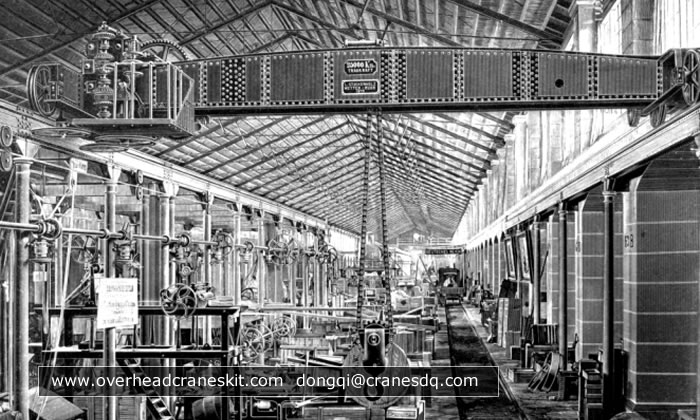Crane Wiki: what is a crane and crane development evolution history
Crane Wiki: what is a crane
A crane is a type of machine, generally equipped with a hoist rope, wire ropes or chains, and sheaves, that can be used both to lift and lower materials and to move them horizontally. It is mainly used for lifting heavy things and transporting them to other places. It uses one or more simple machines to create mechanical advantage and thus move loads beyond the normal capability of a human. Cranes are commonly employed in the transport industry for the loading and unloading of freight, in the construction industry for the movement of materials and in the manufacturing industry for the assembling of heavy equipment.
Crane Wiki: how the crane invented
Ancient Greek scientist Archimedes once said: “Give me a fulcrum and a long enough lever, I will be able to leveraging the whole earth.” This principle was exploited by China’s irrigated farmland and irrigated water orange, which had been in use since the Spring and Autumn Period. Orange can be said to be the first ever jib crane. Its structure, equivalent to an ordinary lever. In the middle of its horizontal bar by the vertical wood support or suspended from the bar with one end of the rod connected with the drain device, the other end tied or hanging a heavy stone. When not to draw water, the stone position is low (bit energy is also small); when to draw water, people will force the straight rod and the drain device down pressure, at the same time. The other end of the stone position is increased (bit energy increase). When the drain is full, let the other end of the stone down, the stone of the original storage of potential energy can be transformed: the role of leverage, it may boost the device. Thus, the main force of the water drawing process is downward. As the downward force can help people’s weight, which gives a relaxed feeling, it will greatly reduce the degree of people’s water fatigue. This water-lifting tool is one of the main irrigation machinery in ancient China. In the three Kingdoms period, Ming improved it, and invented the waterwheel, also known as Kong Ming car.

The simply crane system
10 BC, the ancient Rome architect Vitruvius described a crane in his construction manual. This machine has a mast, pole top with pulley, fixed by the lanyard mast position, with the winch pull the cable through the pulley to lift heavy objects. Some crane can be used two masts, constitute a chevron, the hanging objects horizontal movement, but the magnitude is very small, the operation is also very difficult.
The ancient Greeks (3rd century BC) made the earliest mechanically constructed cranes based on the principle of leverage, which used two fixed pulleys and a movable pulley.

Greco-Roman Pentaspastos (“Five-pulley-crane”), a medium-sized variant (ca. 450 kg load)
Crane Wiki: crane development in the 14th-19th century
In the 14th century, maneuvering and animal-driven rotary boom-type cranes were introduced in Western Europe. In the early nineteenth century, the emergence of bridge cranes; crane important wear parts such as shafts, gears and spreader, etc. began to use metal materials, and began to use hydraulic drive. In the late nineteenth century, steam-driven cranes gradually replaced hydraulic-driven cranes. Demag at the 1873 Vienna World Expo launched the world’s first steam-driven crane, the bridge crane already has the prototype of modern cranes, from the weight of 16t, there was no electricity, the use of steam as a power source, structural parts using riveting . From the launch of the world’s first steam crane that day, DEMAG has been stand tall in the world’s top brand of the most sophisticated cranes. It is also from this day, more than 100 years Demag in the crane design concept has always led the world’s newest trend.

Demag Overhead Crane
Crane Wiki: the development of cranes in Modern Times
20 years of the 20th century, the electrical industry and the rapid development of the internal combustion engine industry to motor or internal combustion engine powered device for the formation of a variety of cranes. In 1938 yale invented the wire rope hoist. In 1944 shepard-niles in New Mexico to hoist the atomic bomb with a gourd to do the test. 1969 Power Electronics International, Inc. has developed a slow-driven gourd. In 1983, when the world’s largest overhead crane in Itaipu power plant in Brazil put into use.
The late 20th century to recent years, the world’s rapid development of the crane industry, China’s crane industry has gone from imitation to independent research and development, from small to heavy load weight of the development process. In the early stages of development to introduce advanced foreign technology-based, through digestion and absorption, for my use. Late to product improvement or innovation, to create more in line with China’s national conditions of the crane products.
Crane Wiki: the development of the crane at present
At present, the development of the crane mainly in the following trends:
- light;
- modular;
- intelligent;
- new product structure, beautiful
- After-sales service fast, professional, humane
Crane types continue to increase, at present mainly formed a bridge crane, gantry cranes and light small cranes and several other categories, each category can be divided into several sub-categories. Products related to the field of iron and steel, coal, electricity, metallurgy, petroleum, chemical, aerospace, shipbuilding, military, machinery manufacturing, rail transportation and other related to the national economy and the various sectors of the people. With the continuous improvement of the level of machinery and equipment manufacturing, lifting industry will also step onto a higher level, to create a more advanced performance fine, safe and reliable products.

Heavy duty double girder overhead crane
Into the twenty-first century, Dongqi Crane independently developed by the QDX series of lightweight cranes, can reach the international advanced level. The whole machine adopts modular design, PLC programming control and frequency conversion speed control, and can access the latest security monitoring system installed in the industry. Compared with the traditional bridge crane, QDX series cranes light weight, reducing the 1/3 or so; clearance height is low, lifting a high degree, can save plant height and civil investment; smooth operation, the impact of the plant is small, Plant life; low noise, measured less than 60dB, more conducive to the physical and mental health of the workshop workers, in line with today’s humane, ergonomic design. With the QDX crane scale, batch production, the cost advantage will be further demonstrated, compared with the traditional bridge crane will be more advantages, will eventually replace the traditional bridge crane.




